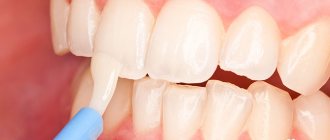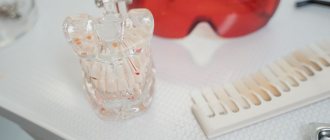If you have a sore throat, a stuffy nose, and a general feeling of malaise, then these are obvious symptoms of a cold. What to do if you have an appointment with the dentist at this time - is it possible to treat teeth if you have a cold? It is impossible to answer this question unequivocally, since most often it is better to postpone a dental appointment until recovery.
Content:
- When treatment is necessary
- When is it not recommended to treat teeth for a cold?
- High fever and toothache control
- What to do if you had to postpone your visit to the doctor due to a viral disease
Treatment of toothache during acute respiratory viral infections and acute respiratory infections has a number of features.
Due to the disease, a person’s immunity decreases, which means that the body may respond inadequately to any intervention. It is especially dangerous to carry out drainage and other invasive dental operations at this time. Therefore, dentists usually do not recommend coming for an appointment if you are not feeling well. The difficulty lies in the fact that with a runny nose or headache (and these are quite common signs of ARVI), it is difficult to sit for a long time in a doctor’s chair with your mouth open. But it is not always possible to postpone a visit to the dental center. If a doctor’s help is needed urgently, it is recommended to come for an appointment, regardless of the symptoms of a concomitant illness. The doctor will conduct an examination and tell you whether your teeth can be treated for a cold or whether therapy should be postponed.
Sinusitis
Another disease not related to teeth, but which gives characteristic pain and temperature is sinusitis. Caused by inflammation of the maxillary sinuses. They destroy the wall adjacent to the oral cavity, so the sensation is reminiscent of toothache.
Sinusitis causes similar symptoms
Sinusitis can result from the following diseases:
- ARVI;
- acute or chronic rhinitis;
- chronic tonsillitis (inflammation of the tonsils);
- damage to the teeth of the upper jaw by caries.
Important ! Patients with such anatomical features as narrowing of the nasal passages and deviated septum are at risk. Another cause of sinusitis is errors during surgical interventions on the upper jaw.
With sinusitis it is also difficult to breathe through the nose
One of the symptoms of sinusitis is an increase in temperature to 39 degrees. The disease is accompanied by severe pain in the forehead, nose, maxillary sinuses and cheekbones. It becomes difficult to breathe through the nose, and as the disease progresses, greenish discharge appears.
When treatment is necessary
Among the situations when treatment of an oral disease is urgently needed:
- The ailments appeared a few days after the toothache began or simultaneously with it. This may indicate that a condition mistaken for a cold is, in fact, a sign of the progression of dental pathology. For example, weakness, migraine and high body temperature often indicate the progression of pulpitis, inflammation of a dental root cyst, and damage to soft tissues.
- The pain in the unit is so severe that it cannot be reduced with modern analgesics. Then the person takes one tablet, followed by a second. Then he changes the painkiller to a stronger one, but all attempts made are in vain. Most often, severe discomfort occurs during purulent processes. These are always difficult and dangerous conditions. If they are not diagnosed and treated in time, pus can spread through the bloodstream throughout the body. The consequences of this will be sad - even death.
- Pus is released from the diseased unit, body temperature is constantly elevated and practically does not decrease after using an antipyretic. This symptom complex indicates a serious inflammatory process. It needs to be stopped as soon as possible.
- A jaw injury was sustained. In the first hours after damage to the dental crown, certain measures can be taken to restore it. If you wait, then it will not be possible to restore the integrity of the surface of the unit in a natural way - you will have to carry out prosthetics in the future.
In these situations, the dentist will definitely provide treatment, regardless of the patient’s cold symptoms.
Alveolitis
In some cases, pain and fever begin immediately after tooth extraction. For the first two days, this is acceptable, especially in cases where the process was complex and it was necessary to operate on the gums or extract parts of the tooth. In such cases, the temperature may rise for up to a week, gradually decreasing. However, you need to remain under the supervision of a doctor until the symptom goes away completely.
High temperature occurs in cases where wound healing after dental extraction does not proceed as expected. Alveolitis occurs - inflammation of the tooth socket. Most often, this happens because the wound left after extraction becomes infected, and the blood clot, which normally protects the wound from external influences, is missing or damaged for some reason.
Alveolitis occurs due to infection entering the socket
As a rule, the clot is damaged if the dentist’s recommendations are not followed correctly (mechanical damage to the clot when eating or brushing teeth, vigorous rinsing of the mouth, etc.). Another reason is weakened immunity.
Important ! Also, the clot can be damaged due to erroneous actions of the doctor.
The following symptoms indicate alveolitis:
- increased pain after tooth extraction;
- increased body temperature (above 38-39 degrees);
- the appearance of plaque on the hole;
- unpleasant taste in the mouth, odor;
- swelling of soft tissues;
- enlarged submandibular lymph nodes;
- weakness and malaise.
With alveolitis, the temperature also rises
Treatment methods for alveolitis
This is a serious complication that requires long-term and complex therapy. The set of treatment measures is as follows:
- The dentist thoroughly sanitizes the hole, removing all foreign particles: food debris, tooth fragments, etc.
- The wound is washed with antiseptics, excess fluid is removed from it, and if necessary, antibacterial treatments are used.
- A bandage is applied to prevent pathogens from entering the wound.
- Physiotherapy is prescribed: laser, ultraviolet or microwave treatment, fluctuarization.
- The patient is advised to take antibiotics and antiseptics prescribed by the doctor.
Fluctuarization
When is it not recommended to treat teeth for a cold?
If a person has an appointment at the clinic, but fell ill the day before, he should cancel the visit to the doctor in the following cases:
- Treatment of unadvanced caries was planned. If the unit does not hurt, it is quite possible to shift the therapy to 7-10 days. Usually this period is enough to completely recover from ARVI. During the days of treatment for ARVI, maximum attention should be paid to carious cavity care. It is important to clean it of food debris after every meal. In order to slow down the process of destruction of dental tissues, you need to treat them twice a day with a special remineralizing gel. You can buy it at the pharmacy.
- A high temperature is caused by a cold. Fever is a contraindication to any dental intervention.
- A planned removal is required. The period of illness is not at all suitable for such operations. First, the body may react poorly to the anesthetic drug. Then a severe allergy will develop. Secondly, the immune system spends all its energy trying to defeat the virus. This means that the healing processes in the socket area will proceed more slowly, and the risk of wound infection will increase.
- On the eve of visiting the dentist, the patient took acetylsalicylic acid. A week before dental procedures, you should stop using this drug. This is due to the fact that Aspirin strongly thins the blood. This increases the risk of bleeding even with minor medical manipulations.
- The nose became very stuffy, and nasal breathing became impossible. While the doctor is treating the affected molar, canine or incisor, the patient has to breathe through his nose. He simply cannot take a full breath through his mouth. But, if you don’t want to put off visiting the doctor, you can cheat a little - use an effective vasoconstrictor spray ten to fifteen minutes before entering the dentist’s office. True, the drug for rhinitis will still have to be agreed upon with the dentist. After all, it is possible that it will be incompatible with the medications that the dentist will use during treatment.
It is important to understand that the final decision on the advisability of therapy during a cold should be made by the doctor. If a person doubts that a visit to the clinic can be postponed, he should call the dental center and consult with a specialist by phone. This is a fairly common practice.
Is it possible to have a tooth removed during a cold?
The main risk when removing a tooth is the possibility of infection of the open wound. Normally, a healthy immune system prevents this. If you have a runny nose, an extra load on the immune system is extremely undesirable, so the doctor’s task, in addition to carefully removing the tooth, is also to carry out certain measures:
Disinfection of the oral cavity - treatment of the entire mucous membrane, herpes wounds, cracks on the lips and other possible sources of infection. Treatment of the wound with bactericidal preparations upon completion of the procedure. Prescription of antibacterial agents. Selection and prescription of medications aimed at strengthening the body’s protective functions, activating and regenerating tissues.
Upon completion, it is important to monitor the general condition, since pain or high temperature may indicate both symptoms of the disease and signs of a developing inflammatory process.
High fever and toothache control
Most dentists agree that when the body temperature is elevated, it is not advisable to deal with dental problems. The body already has a difficult time - it is fighting the virus, trying to destroy pathogenic microflora. Additional intervention may negatively affect the speed of recovery. Moreover, with a cold, any wounds that arise after medical manipulations heal more slowly. Consequently, the risk of secondary infection increases sharply.
But the situation is completely different if the temperature is not a symptom of ARVI, but a consequence of tooth inflammation. Here, waiting for a runny nose or cough to go away is unacceptable. You should visit a doctor as soon as possible. Even a tiny dental root cyst can cause problems that lead to partial edentulism.
What to do if you had to postpone your visit to the doctor due to a viral disease
Doctors most often do not recommend self-medication at home. But, if there is a dental problem, and it will be possible to visit a specialist only after some time, the patient needs to take responsibility for his health.
Following a number of rules will help here:
- Put oral hygiene first. Use the brush and paste morning and evening. After each meal, rinsing with warm water or a special rinse is recommended.
- Drink plenty of fluids. This will reduce the symptoms of intoxication, which may be a consequence of viral disease and tooth inflammation.
- Take medications aimed at relieving ARVI symptoms. They usually contain painkillers and anti-inflammatory compounds that quickly relieve pain (including dental pain).
- Dissolve menthol tablets. They reduce discomfort in the throat and distract if only one is aching. Menthol provides a weak anesthetic effect, but is safe for health. The only thing is that the component cannot be used by people who are allergic to it.
- Make mouth baths with soda and salt. To prepare a medicinal solution, half a teaspoon of one of these compositions is dissolved in a glass of warm water. Take the liquid into your cheek (from the side of the painful tooth) and hold it for several minutes, then spit it out. Repeat the procedure several times in the morning, lunch and evening. Baking soda and salt perfectly relieve inflammation, destroy bacteria and “pull out” pus. It is very important that the water in which they are dissolved is warm and not hot.
- Avoid eating sweets, sour and spicy foods. When the enamel is thinned, such food aggravates the course of the disease.
- Don't chew anything hard. Nuts, candies, crackers - these and other hard goodies are prohibited until a doctor cures an oral disease.
- Chew food on the healthy side of the jaw. It is advisable to try to temporarily reduce the load on the “culprit of pain”.
As soon as your health returns to normal, you should immediately go to the dentist. Then the doctor will safely treat the affected unit.
Take care of yourself and do not develop dental diseases. Visit your dentist annually, even if you don't have a toothache or notice any new cavities. Regular examinations are the best preventative measure.
Periostitis
If you start periodontitis and do not start treatment on time, an even more serious complication may arise - periostitis. In this case, the periosteum and jaw bones become inflamed. Abscesses form and purulent inflammation develops. Pus comes out of the abscess through the fistulous tract. Symptoms of periostitis are as follows:
- How long does it take for drugs to leave the body?
- acute toothache;
- temperature increase;
- facial tissues swell greatly on one side;
- weakness from intoxication;
- the pain radiates beyond the affected area - to the temples, ears, neck, eyes.
Periostitis most often occurs as a complication of periodontitis
Important ! If periostitis develops, the gums swell not only around the affected tooth, but also around nearby teeth.
Treatment methods for periostitis
Under no circumstances should you self-medicate and the patient should immediately go to an emergency dental care center. There they determine how the treatment will be carried out - surgically or conservatively.
Treatment is either surgical or conservative
With the surgical method, a purulent abscess on the gum is operated on and the contents are drained; In order to avoid the accumulation of pus, drainage is installed. The actions are carried out under local anesthesia.
Important ! If the tooth is too damaged and conservative treatment does not help, extraction is performed. If the condition of the tooth and adjacent tissues allows, the canals are cleaned and a filling is placed.
During the rehabilitation period, physiotherapy is prescribed and antibiotics are prescribed.











